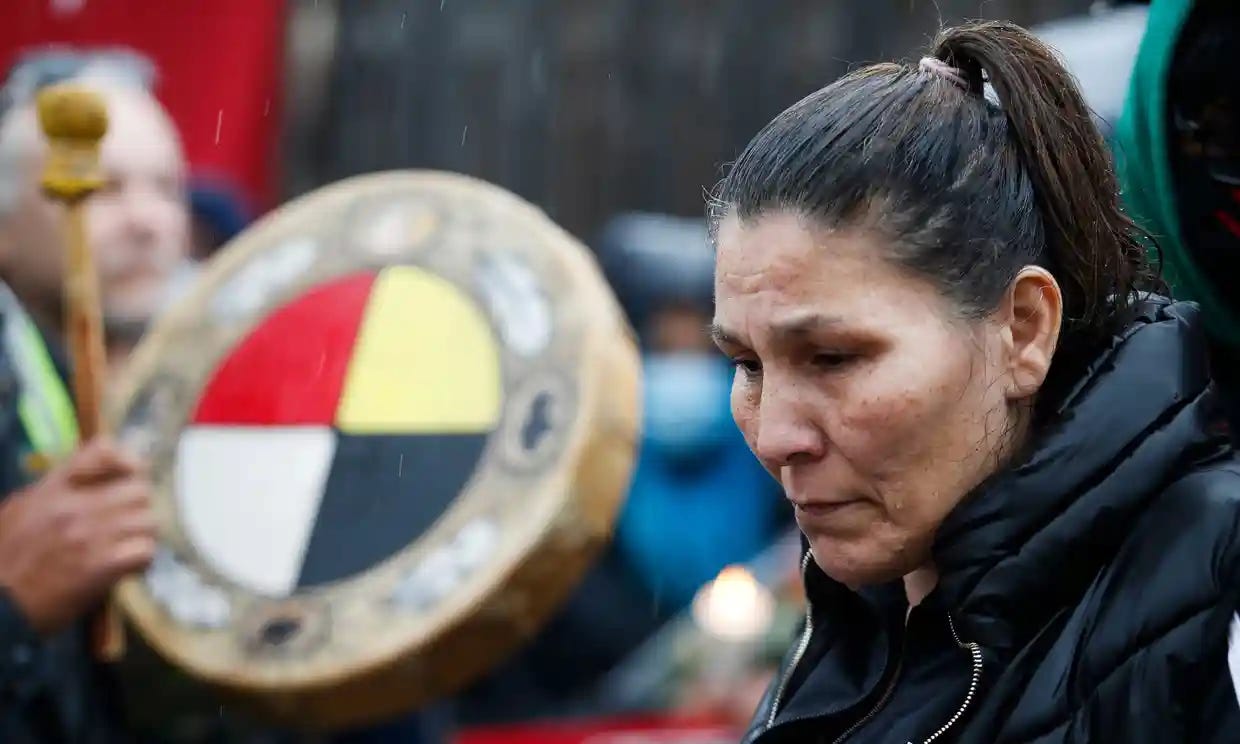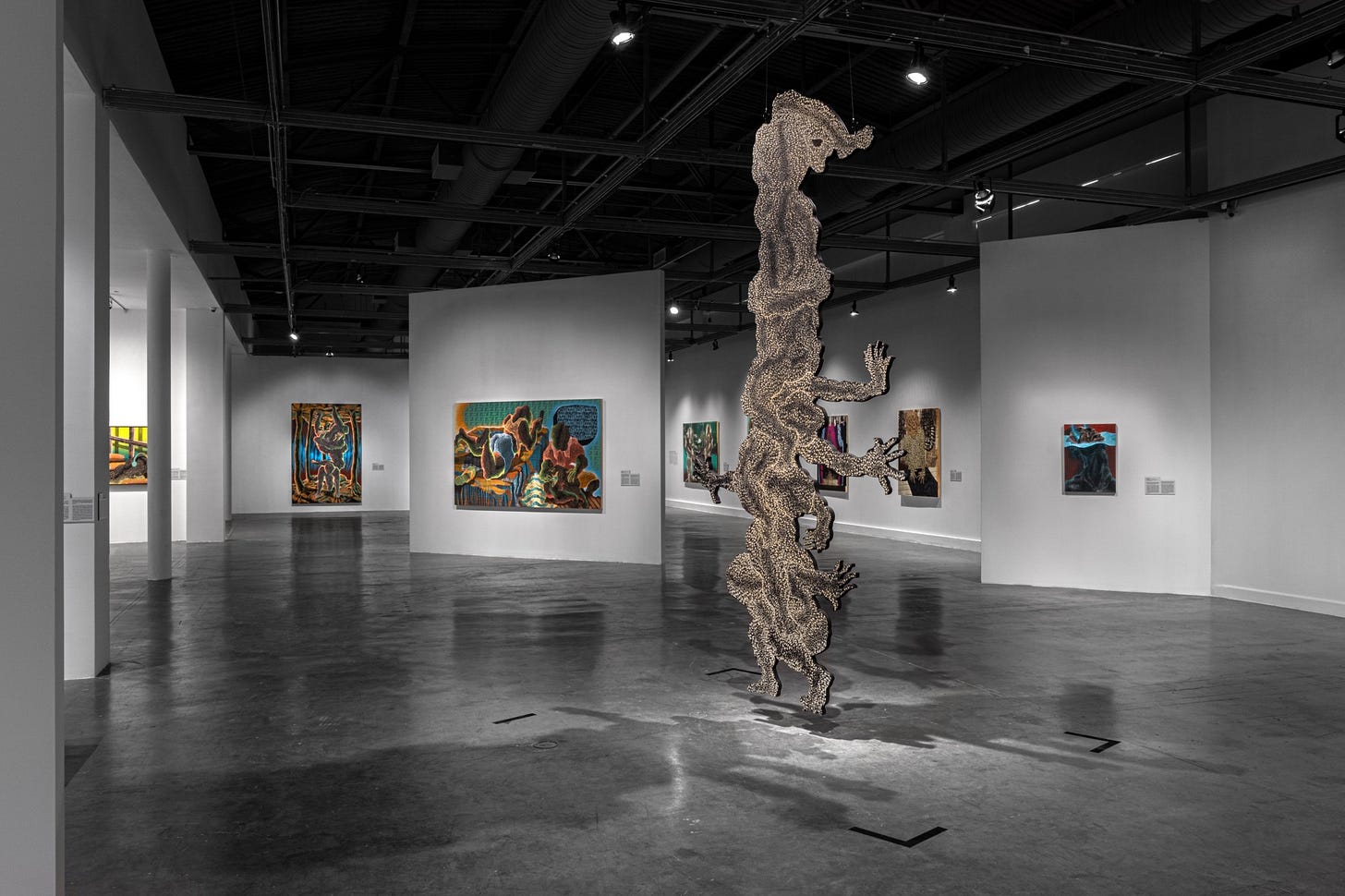Global Roundup: Canada Indigenous Women, Dalit Queer Voices, Africa's Women-Led Skateboard Scene, Exhibition for Black Queer Immigrants, Reclaiming Stories About Queer POC
Curated by FG Contributor Samiha Hossain
A vigil held in May 2022 for Rebecca Contois in Winnipeg, Canada. Photograph: Canadian Press/REX/Shutterstock via The Guardian
CW: gender-based violence
The arrest of an alleged serial killer who targeted Indigenous women in central Canada has prompted fresh anger and despair that the country has once again failed in its promises to protect vulnerable women and girls. Last week, police in Winnipeg announced they had charged Jeremy Skibicki with the murder of Morgan Beatrice Harris and Marcedes Myran of Long Plain First Nation, months after he was accused of killing Rebecca Contois from O-Chi-Chak-Ko-Sipi First Nation. Skibicki was also charged in the murder of a fourth, unnamed victim who is believed to be Indigenous. The bodies of the three latest alleged victims have not yet been found.
A candlelight vigil was held in Winnipeg outside Skibicki’s home as families grieved the loss of mothers, daughters and a grandmother.
I want her to be remembered as happy-go-lucky. She was silly. She was fun. People loved to be around her. -Cambria Harris, Morgan’s daughter
The Manitoba shadow justice minister Nahanni Fontaine said on Twitter that she and others were experiencing “rage, despair, disgust and unspeakable sadness” following the arrest of a “monster” who had stalked the community.
When will the protection of Indigenous women, girls and two-spirited be taken seriously? Winnipeg now has the distinction of having two separate serial killers of Indigenous women. Are we waiting for a third or fourth to rear their murderous heads? -Nahanni Fontaine
For some, the grief was compounded by political leaders’ failure to keep promises to combat decades of violence against Indigenous women. As many as 4,000 Indigenous women and girls are believed to have been killed or gone missing in Canada over the past 30 years – although the true number of victims is unlikely ever to be known. A report by the National Inquiry into Murdered and Missing Indigenous Women and Girls found that Indigenous women are six times more likely to be murdered than non-Indigenous women.
Police in other regions of the country have recently faced scrutiny over reports that Indigenous people are over-policed but crimes against them are under-investigated. In Ontario, a group of independent investigators have called for the reinvestigation of the sudden deaths of 14 Indigenous people in the city of Thunder Bay, after finding that the original inquiries were hampered by sloppy police work and a legacy of institutional racism.
Photographed by Harshini J. Karunaratne via Vogue India
As an artist, I feel like my job is to see what is not visible and make it visible, and to also see what is being systematically erased. Dalit queer people have been around forever, but there was zero collectivisation before Dalit Queer Project. -Aroh Akunth
A collaborative space that aims to hand over the mike to marginalized voices, Dalit Queer Project’s Instagram profile serves as a living archive of caste and queerness in the virtual space. There are poetry readings, literary workshops and portrait testimonials that record Dalit queer persons thinking through their identities and interrogating how it recontextualises caste. Slowness of process is important to Akunth, which is why Dalit Queer Project’s Instagram profile has only 93 posts, instead of acquiescing to the demands of the algorithm.
All Dalit people inspire me. The way formerly untouchable people have organised around caste struggles, very senior Dalit artists like Gogu Shyamala and Bama who have contributed their work to our Dalit Art Archive... I am because they are. -Aroh Akunth
Dalit Art Archive is a repository of community knowledge featuring interviews with Dalit artists and community historians and follows a model similar to Dalit Camera, a news website and YouTube channel set up in 2011 which focuses on journalism.
Akunth is currently finishing their Masters in Modern Indian Studies from the University of Göttingen in Germany, and have their hands full with film programming (screenings, academic research and podcasting) around caste; as well as planning a mural on caste and queerness in Delhi in collaboration with the Aravani Art Project. They are also part of the Asian Performing Arts Lab, editing a literary anthology and films on/by Dalit queers, and working on their own collection of short stories and critical essays.
Thato Moet (left) with members of Island Gals ShredKarabo Mooki via Condé Nast Traveller
Nigeria barely had a women’s skate scene two years ago, but Blessing Ewona is changing that fast. The 25-year-old founded Dencity, an all-female skating community, in 2021, a year after she and a friend first took up the sport but found themselves navigating an almost entirely male scene.
They were calling girls ‘poseurs’ and teasing them and all that. I created Dencity so that it would be easier for us girls to connect and skate together. -Blessing Ewona
The community, now dozens strong, hangs out mainly on the paint-stripped expanse of concrete around the National Stadium in Lagos, plus a sprinkling of locations in cities including Ibadan and Port Harcourt. As equipment is not widely affordable and spaces are thin on the ground, Dencity receives boards from various donors as well as its sponsors.
When Thato Moet saw a group of boys skating by a shopping centre in Johannesburg’s Soweto township in South Africa, the then 15-year-old bought a skateboard the very next day. Tired of the trash talk and testosterone, Moet set up the Island Gals Shred group in 2019 to teach girls tricks in relative peace. Since then, numbers have grown to the extent that they recently hosted a competition as part of South Africa’s Women’s Month. Moet hopes to reach the whole of South Africa and get more funding so she can swap her well-worn Vans threads for branded Island Gals Shred T-shirts and merchandise. When she’s on wheels, Moet feels ready to take on anything.
It gives you this ‘I can beat anyone with my skateboard’ vibe. I like the feeling of flying. I like the adrenalin. -Thato Moet
Wafa Heboul in action Claudia Lederer
Wafa Heboul is Morocco’s most high-profile female skateboarder. At the age of 15, she started learning in Agadir and was immediately hooked – later moving to Taghazout, where a new Seventies California-style skatepark overlooks the sparkling blue waves of the bay.
When I’m skateboarding I’m happy and free. It’s a tool for me to express myself. -Wafa Heboul
Now aged 28, she recently represented Morocco in the Olympic qualifiers in Iowa. Despite the fact that she did not make the cut, messages of support and requests for advice came flooding in from girls back home. Her friend Faiza Moumane has launched Wheels n Fins, an initiative encouraging people to take up the sport. The pair now organize “girls days” which include lessons and barbecues.
Installation view of Didier William’s 2022 exhibition “Nou Kite Tout Sa Dèyè” (“We’ve Left That All Behind”) at MOCA North Miami.PHOTO MICHAEL R. LOPEZ. COURTESY MOCA NORTH MIAMI
The irony of the exhibition title is that you can never leave it all behind. It follows you and is sort of imprinted onto you. It points to something that is a reality for all of us who move from one place, especially from one country, to another—that your cultural DNA stays with you. -Didier William
Beginning with new artist books in the lobby and moving to a documentary about William’s family history by Emmy-nominated filmmaker Marlon Johnson, the exhibition considers the notion of home. New paintings of the first two houses in which William remembers living in Miami are set in a dark, intimate space. Notably, however, these are not the first places William and his family lived in North Miami. The artist aimed to portray the homes as accurately as possible, yet he also added a surreal touch: the structures are shown nestled among a sea of limbs.
William’s works, which are often made in series, draw on his own memory. They weave in the 39-year-old artist’s own recollections about immigration and Haitian religion while also speaking to broader themes related to Black and queer communities. Questions of belonging, the negotiation of new spaces and identities, and perseverance in times of personal struggle are at the forefront.
As a Black, queer immigrant in the United States, a mid-career showing of William’s oeuvre is perhaps as much a testament to perseverance as much as it is to occupying space—which has become all the more difficult in a country that has had its fair share of anti-Black violence as well as legislation that has disenfranchised immigrants and the LGBTQ+ community.
This country has always grappled with immigrants and belonging from its inception. And I don’t think that conversation will ever end. -Didier William
Myles Loftin's 2022 portrait of a member of House of LaBeija in his "True Beauties" photography series. MYLES LOFTIN via HuffPost
Myles Loftin's career took off when he was a student and worked on a photo project called “HOODED.” Its intent was to offer a counter-narrative to the widespread stereotypes about Black men in hoodies; namely, that a Black person wearing one is criminal by default. To turn that on its head, “HOODED” featured joyfully nuanced images of Black men in colorful hoodies, smiling, hugging each other and frolicking. Loftin has held on to the ethos that gave birth to “HOODED” throughout his flourishing career, which includes high-fashion print covers. The 24-year-old says that, although the project was criticized by some for the perceived feminization of the men in it, he believed that those people were just uncomfortable because they were not used to seeing Black men embracing the radical act of joy.
One of Loftin’s recent and notable portrait series features members of the House of LaBeija, a ballroom house that has welcomed Loftin in as chosen family. Their expressions of transness and queerness, manifested through movement and clothes, have helped Loftin step into his own identity and sustainable peace.
When Justin J. Wee is not shooting, he does drag — and the two worlds overlap in harmonious, unexpected ways. He points to the ways in which both mediums allow him to see himself and others in ways that feel complicated, multilayered and ultimately freeing. His drag challenges his relationship to himself in a way that his photography does for others.
As Asian folk, we’ve been indoctrinated in a very specific form of masculinity or culture or obligation to our families, and I really want to see myself in a way that I wasn’t allowed to as a kid. I just want to reclaim that for myself. -Justin J. Wee
Kamyiis Mclean is similarly on a photographic journey that involves both reclaiming his narrative and helping others craft and nurture their own. He was born and raised in Jamaica and moved to New York in 2016 to pursue his dreams of photographing queer people and fashion, two subjects that were not particularly favored back home. His images often include subjects adorned in garments and accessories that are meant to harness their inner majesty. The 25-year-old got his first big break during the pandemic and the Black Lives Matter protests, when he took a picture of a person holding a sign that said “Power to the People,” which went viral.
Samiha Hossain (she/her) is a student at the University of Ottawa. She has experience working with survivors of sexual violence in her community, as well as conducting research on gender-based violence. A lot of her time is spent learning about and critically engaging with intersectional feminism, transformative justice and disability justice.
Samiha firmly believes in the power of connecting with people and listening to their stories to create solidarity and heal as a community. She refuses to let anyone thwart her imagination when it comes to envisioning a radically different future full of care webs, nurturance and collective liberation.







